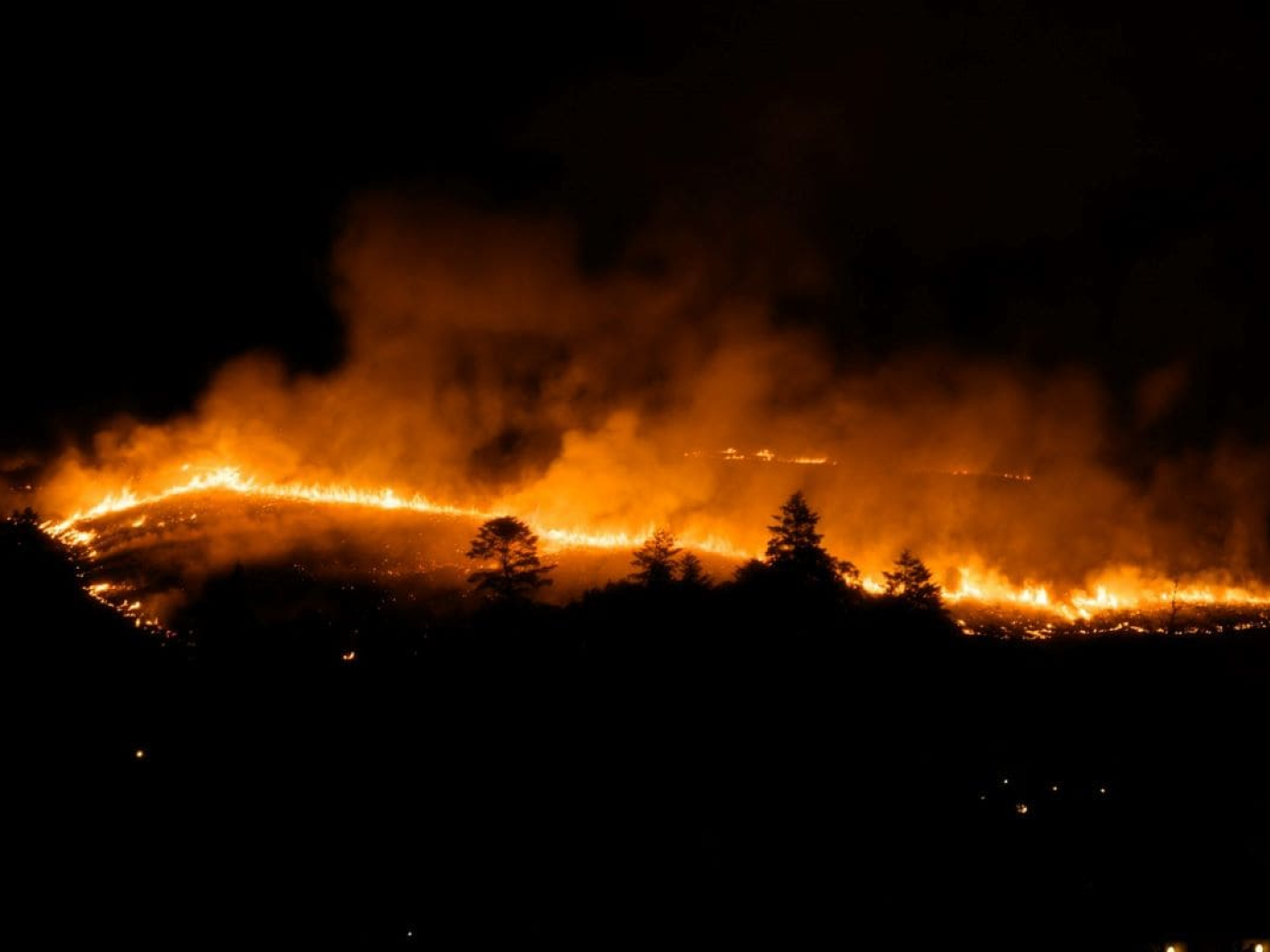This article is also available in Italian / Questo articolo è disponibile anche in italiano
Summer is also, unfortunately, the season of fires, due to rising temperatures, dry soil and vegetation, and decreasing rainfall, which cause fires or fuel those started by humans. But climate change is exacerbating these conditions, fuelling an increasingly serious vicious circle of cause and effect. And the summer of 2025 provided a sad demonstration of this.
Wildfire activity across the Iberian Peninsula during the summer of 2025 has reached exceptional proportions, triggering record levels of atmospheric emissions and widespread ecological, economic, and social disruption. According to the Copernicus Atmosphere Monitoring Service (CAMS), Spain has already recorded the highest annual wildfire carbon emissions since at least 2003, the beginning of the CAMS dataset. Within a matter of days in early August, emissions surged from below average to historic highs, marking what scientists describe as an unprecedented acceleration.
As southern Europe faces continued heat and dryness, and as North America endures parallel crises, the outlook underscores a narrowing window for effective climate mitigation. Without decisive reductions in greenhouse gas emissions and enhanced resilience strategies for fire-prone regions, the “new normal” may be defined by seasons like 2025: unprecedented in speed, scale, and consequence.
Spain’s Fires Reach Historic Intensity
The pace and scale of fire development in Spain have been extraordinary. As July closed, cumulative emissions for the country remained below the seasonal mean. Yet by mid-August, widespread fires in north-western regions including Castilla y León, Galicia, Asturias, and Extremadura pushed annual emissions beyond every previous year in the 23-year Copernicus record. Satellite-derived fire radiative power (FRP) confirmed a near-vertical increase in the daily emissions curve, underscoring the abruptness of the escalation.
The consequences on the ground were severe. More than 120,000 hectares were burned in August alone, thousands of residents were evacuated, and critical infrastructure was disrupted. Spain’s high-speed rail line connecting Madrid and Galicia was closed, while at least a dozen regional roads remained impassable. Tragically, at least three fatalities were reported. The Military Unit for Emergencies (UME) was deployed extensively to support overwhelmed firefighting teams.
The impacts extended far beyond the immediate fire zones. CAMS reported fine particulate matter (PM2.5) concentrations well above the World Health Organization guideline of 15 μg/m³ for 24-hour averages. Local air quality networks across Spain confirmed elevated readings, with smoke plumes dispersing hundreds of kilometers and degrading atmospheric conditions across large swathes of the peninsula.
Portugal and France Under Strain
Neighbouring Portugal has also faced intense wildfire activity since late July. More than 3,600 firefighters were deployed, particularly in the northern regions, while a major outbreak in central Portugal prompted the government to declare a state of emergency on 2 August. The declaration has been renewed continuously since. Despite extensive efforts, one firefighter lost his life combating the flames.
CAMS data show that Portugal’s wildfire emissions in 2025 are already approaching the record totals observed in 2003 and 2005, placing this season among the most severe in recent memory.
Across the border in France, extreme heat has intensified fire risk in the Mediterranean. On 4 August, a major fire in the Aude department, between Carcassonne and Perpignan, burned 17,000 hectares and was described as the worst fire in half a century for the region. The persistence of high temperatures in the southeast continues to drive extremely high risk indices.
Smoke from the Iberian Peninsula traveled across France, the United Kingdom, and into Scandinavia, compounding the haze caused by Canadian wildfire smoke drifting across the Atlantic. Observations confirmed transboundary pollution events, highlighting how wildfire impacts are no longer confined to local or even regional scales.
Air Quality and Health Concerns
One of the most critical aspects highlighted by CAMS is the degradation of air quality. Wildfire emissions release large quantities of carbon dioxide, carbon monoxide, and fine particulate matter, which can remain suspended in the atmosphere for days or weeks. PM2.5 is particularly harmful, penetrating deep into the lungs and bloodstream.
CAMS forecasts showed increased PM2.5 concentrations across the Iberian Peninsula, with levels several times above the WHO safety threshold. Residents far from the fires reported hazy skies, reduced visibility, and elevated respiratory discomfort. Epidemiological studies from previous wildfire events suggest that sustained exposure to PM2.5 at these levels could trigger spikes in hospital admissions for respiratory and cardiovascular conditions.
The Copernicus system combines satellite observations with atmospheric circulation models to forecast the transport of aerosols and pollutants for up to four days. These forecasts have been critical in enabling national authorities to issue health advisories, reroute transport, and anticipate cross-border smoke impacts.
North America’s Parallel Fire Season
While Europe battles its most severe fire season in decades, North America is also experiencing widespread wildfire activity. In Canada, the provinces of Saskatchewan and Manitoba remain the most affected, making 2025 the country’s second most severe fire season on record, surpassed only by 2023. In the United States, significant fires continued through July and August across Nevada, Arizona, Utah, and Colorado, producing major smoke plumes that occasionally reached across the Atlantic.
CAMS estimates show that fire emissions from North America and the Iberian Peninsula are interacting in the transatlantic atmosphere, creating widespread hazy conditions across western Europe. Such large-scale transport events underscore the global dimension of wildfire emissions in a warming climate.
The acceleration of emissions in such a short period illustrates how climate-driven extremes interact with regional vulnerabilities. Persistent heatwaves since June, exceptionally dry conditions, and recurrent high-risk weather patterns created the preconditions for rapid fire spread. These factors are consistent with broader projections of Mediterranean climate change, which anticipate longer and more severe fire seasons.
At a time when politics increasingly views science as an enemy and cuts funding for climate and the environment solely for electoral gain, the CAMS report demonstrates the indispensable value of continuous monitoring and reinforces the importance of integrating atmospheric monitoring into both emergency response and long-term climate adaptation. The data not only quantify emissions but also trace pollutant transport, enabling decision-makers to better understand regional and global implications.
The 2025 wildfire season across the Iberian Peninsula stands as a stark warning of the compounding risks posed by climate change, land-use practices, and persistent heat extremes. Spain’s highest annual emissions in at least 23 years, achieved within a single week of August, reveal the speed at which ecosystems and societies can be destabilized.
The social and economic toll is already evident: fatalities, evacuations, infrastructure closures, and health impacts from toxic air. The ecological consequences, including the loss of 120,000 hectares of land in Spain in a single month, will reverberate for years in terms of soil degradation, biodiversity decline, and carbon cycle disruption.
Cover: Ro Kazui, Unsplash



